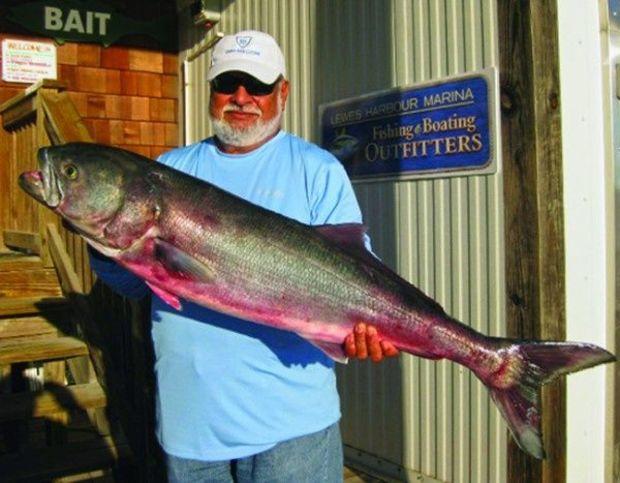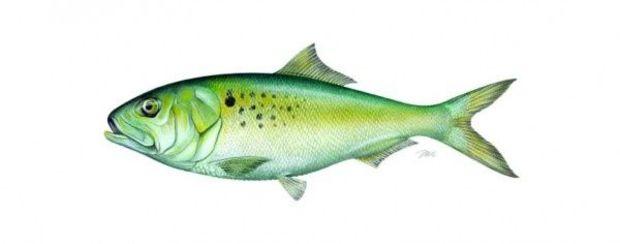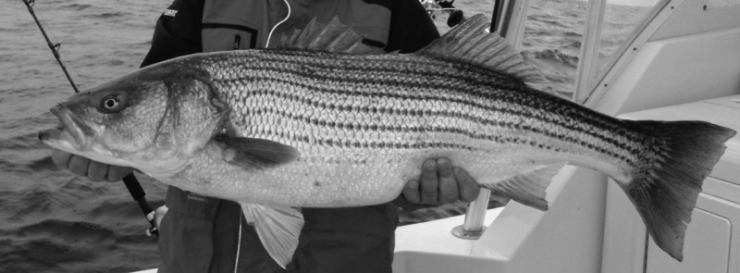 DE Record Bluefish Caught
DE Record Bluefish Caught
This past spring, coastal anglers enjoyed an amazing run of big bluefish in Delaware waters. This fall, Dr. Luis Mispireta of Stevensville, MD, landed the First State’s biggest bluefish on record, a 24.8-pound mega-chopper he caught while fishing over one of the largest artificial reefs on the Atlantic Coast, the reef site known as the Del-Jersey-Land Reef. It was created in 2010 about 25 miles off the coast using, in large part, the decommissioned naval destroyer, the USS Arthur W. Radford.
According to reports, Mispireta was tight to a sea bass when the gorilla bluefish apparently decided it wanted the humpback for a snack. Big mistake, since Mispereta fought the fish stealer to the boat. Joe Morris of Lewes Harbour Marina weighed in the new record bluefish, and Fish and Wildlife Natural Resources Police Officer Joel Brosius verified it.
Mispireta was aboard the charter boat Katydid with Capt. Brent Wiest when he broke the 35-year-old Delaware Sport Fishing Tournament mark, previously set by Bill Thoroughgood of Rehoboth Beach in 1980. Thoroughgood’s record bluefish weighed 21.9 pounds.
 Maryland DNR Clarifies Commercial Menhaden Outlook for 2016
Maryland DNR Clarifies Commercial Menhaden Outlook for 2016
After the Atlantic States Marine Fisheries Commission (ASMFC) menhaden meeting this past November, some confusion surfaced about the results. Maryland DNR Fisheries Service outlined what could happen through 2018 to help clarify; some highlights below:
- In 2016 Maryland will have the same quota as in 2015: 5,674,595 pounds.
- Once the fishery is closed, permitted pound netters (stationary gear) will be able to land 6000 pounds per vessel per day. Gill netters and other gears are restricted to 1500 pounds per vessel per day.
- 2016: If approved by ASMFC, two permitted pound netters on a vessel will be able to land 12,000 pounds of bycatch. Provision does not include coastal gillnetters.
- 2017: ASMFC will likely consider increasing the coastal quota in 2017. Maryland will only get 1.37 percent of any coastal quota increase.
- 2018: This is the year that Amendment 3 could be implemented with new management rules. An option exists to completely revise allocation and provide greater flexibility for Maryland’s fisheries and for non-purse seine (small scale) bait fleets up and down the coast.
- Economic data gleaned from the upcoming ASMFC study
(see PropTalk’s “Profiles in Fisheries” January) on small-scale bait fisheries will help inform
this decision.
- Menhaden will be managed to account for their critical role as forage.
- DNR encourages stakeholders to participate in the upcoming
socio-economic study.
Long Arm of Law to Target Illegal Striper Fishing

As this column goes to press, large, ocean run stripers are running down the coast and up the Chesapeake. Later this winter, these migratory rockfish could either stay within three miles of the coast, where it’s legal to fish for them, or move offshore where the bait and conditions are more favorable.
Over the past decade or so, dedicated striper anglers in the Mid-Atlantic region certainly have heard or perhaps even witnessed scofflaws—sport, charter and commercial fishermen alike—illegally poaching striped bass in the Exclusive Economic Zone (EEZ). In recent years, federal and state marine police have cranked up enforcing federal laws that protect stripers in the EEZ, per the Atlantic Coastal Fisheries Cooperative Management Act.
NOAA’s Office of Law Enforcement (OLE) officers will team up with U.S. Coast Guard and state marine police from November through February to target vessels fishing for and keeping stripers in the EEZ. That includes at-sea, aerial, and dock-side inspections.
Said Lt. Wynn Carney, NOAA’s OLE supervisory enforcement officer, “I am excited about the Mid-Atlantic States conducting a focused enforcement effort. It’s significant that we’re working together toward a common goal.”
by Capt. Chris D. Dollar DE Record Bluefish Caught
This past spring, coastal anglers enjoyed an amazing run of big bluefish in Delaware waters. This fall, Dr. Luis Mispireta of Stevensville, MD, landed the First State’s biggest bluefish on record, a 24.8-pound mega-chopper he caught while fishing over one of the largest artificial reefs on the Atlantic Coast, the reef site known as the Del-Jersey-Land Reef. It was created in 2010 about 25 miles off the coast using, in large part, the decommissioned naval destroyer, the USS Arthur W. Radford.
According to reports, Mispireta was tight to a sea bass when the gorilla bluefish apparently decided it wanted the humpback for a snack. Big mistake, since Mispereta fought the fish stealer to the boat. Joe Morris of Lewes Harbour Marina weighed in the new record bluefish, and Fish and Wildlife Natural Resources Police Officer Joel Brosius verified it.
Mispireta was aboard the charter boat Katydid with Capt. Brent Wiest when he broke the 35-year-old Delaware Sport Fishing Tournament mark, previously set by Bill Thoroughgood of Rehoboth Beach in 1980. Thoroughgood’s record bluefish weighed 21.9 pounds.
DE Record Bluefish Caught
This past spring, coastal anglers enjoyed an amazing run of big bluefish in Delaware waters. This fall, Dr. Luis Mispireta of Stevensville, MD, landed the First State’s biggest bluefish on record, a 24.8-pound mega-chopper he caught while fishing over one of the largest artificial reefs on the Atlantic Coast, the reef site known as the Del-Jersey-Land Reef. It was created in 2010 about 25 miles off the coast using, in large part, the decommissioned naval destroyer, the USS Arthur W. Radford.
According to reports, Mispireta was tight to a sea bass when the gorilla bluefish apparently decided it wanted the humpback for a snack. Big mistake, since Mispereta fought the fish stealer to the boat. Joe Morris of Lewes Harbour Marina weighed in the new record bluefish, and Fish and Wildlife Natural Resources Police Officer Joel Brosius verified it.
Mispireta was aboard the charter boat Katydid with Capt. Brent Wiest when he broke the 35-year-old Delaware Sport Fishing Tournament mark, previously set by Bill Thoroughgood of Rehoboth Beach in 1980. Thoroughgood’s record bluefish weighed 21.9 pounds.
 Maryland DNR Clarifies Commercial Menhaden Outlook for 2016
After the Atlantic States Marine Fisheries Commission (ASMFC) menhaden meeting this past November, some confusion surfaced about the results. Maryland DNR Fisheries Service outlined what could happen through 2018 to help clarify; some highlights below:
Maryland DNR Clarifies Commercial Menhaden Outlook for 2016
After the Atlantic States Marine Fisheries Commission (ASMFC) menhaden meeting this past November, some confusion surfaced about the results. Maryland DNR Fisheries Service outlined what could happen through 2018 to help clarify; some highlights below:
 As this column goes to press, large, ocean run stripers are running down the coast and up the Chesapeake. Later this winter, these migratory rockfish could either stay within three miles of the coast, where it’s legal to fish for them, or move offshore where the bait and conditions are more favorable.
Over the past decade or so, dedicated striper anglers in the Mid-Atlantic region certainly have heard or perhaps even witnessed scofflaws—sport, charter and commercial fishermen alike—illegally poaching striped bass in the Exclusive Economic Zone (EEZ). In recent years, federal and state marine police have cranked up enforcing federal laws that protect stripers in the EEZ, per the Atlantic Coastal Fisheries Cooperative Management Act.
NOAA’s Office of Law Enforcement (OLE) officers will team up with U.S. Coast Guard and state marine police from November through February to target vessels fishing for and keeping stripers in the EEZ. That includes at-sea, aerial, and dock-side inspections.
Said Lt. Wynn Carney, NOAA’s OLE supervisory enforcement officer, “I am excited about the Mid-Atlantic States conducting a focused enforcement effort. It’s significant that we’re working together toward a common goal.”
by Capt. Chris D. Dollar
As this column goes to press, large, ocean run stripers are running down the coast and up the Chesapeake. Later this winter, these migratory rockfish could either stay within three miles of the coast, where it’s legal to fish for them, or move offshore where the bait and conditions are more favorable.
Over the past decade or so, dedicated striper anglers in the Mid-Atlantic region certainly have heard or perhaps even witnessed scofflaws—sport, charter and commercial fishermen alike—illegally poaching striped bass in the Exclusive Economic Zone (EEZ). In recent years, federal and state marine police have cranked up enforcing federal laws that protect stripers in the EEZ, per the Atlantic Coastal Fisheries Cooperative Management Act.
NOAA’s Office of Law Enforcement (OLE) officers will team up with U.S. Coast Guard and state marine police from November through February to target vessels fishing for and keeping stripers in the EEZ. That includes at-sea, aerial, and dock-side inspections.
Said Lt. Wynn Carney, NOAA’s OLE supervisory enforcement officer, “I am excited about the Mid-Atlantic States conducting a focused enforcement effort. It’s significant that we’re working together toward a common goal.”
by Capt. Chris D. Dollar